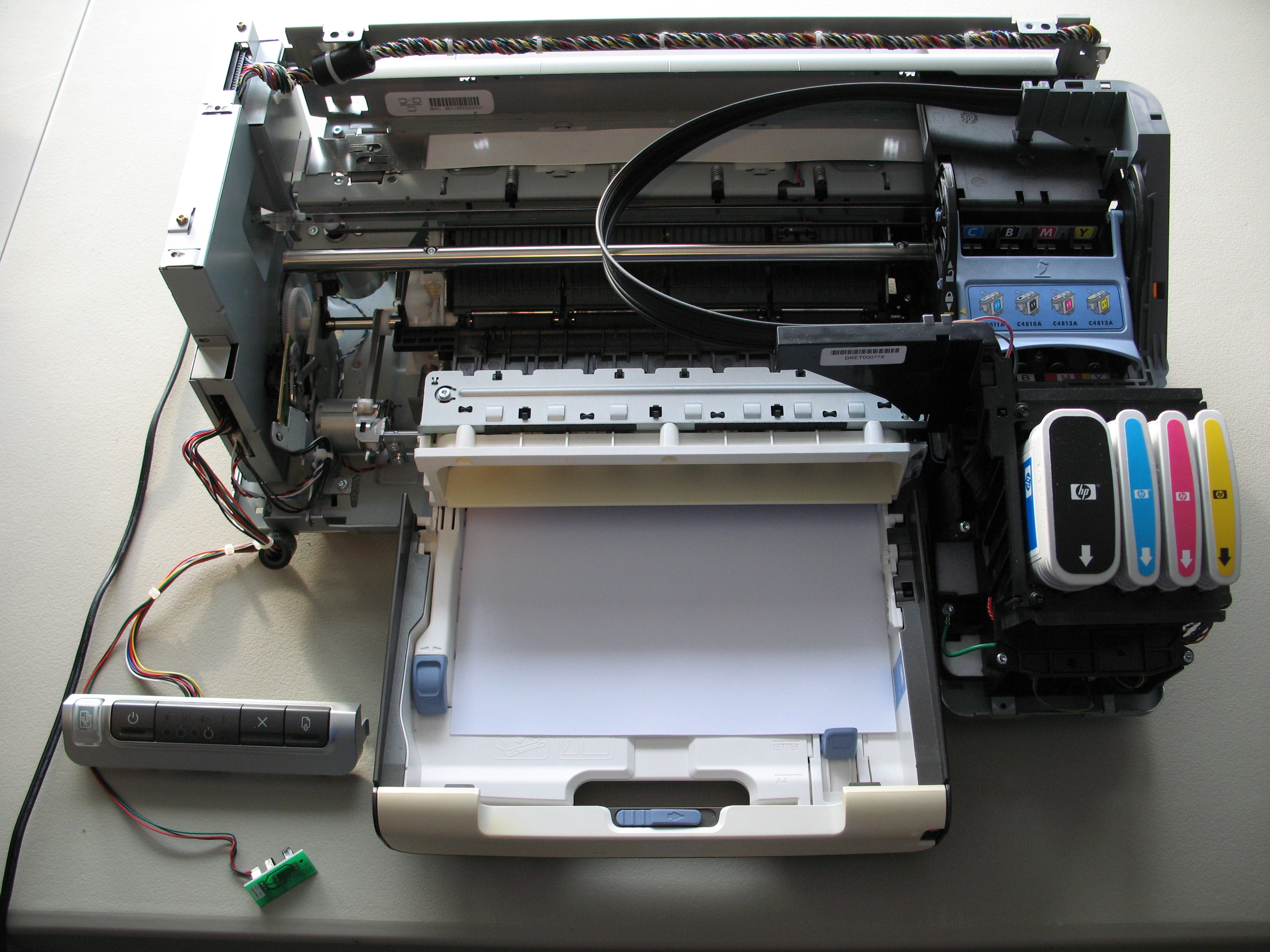|
Supertank Printers
Supertank printers are a type of continuous ink system (CISS) inkjet printer. Supertank printers differ from traditional inkjet printers in that the printhead is connected via a tube system that draws ink from high-capacity ink tanks, which are filled and refilled via high-capacity ink bottles, eliminating the need for ink cartridges. Cost-per-page (CPP) can be significantly lower than traditional cartridges, as replacement ink bottles contain enough ink to print thousands of pages, and typically cost under $20. Supertank printhead types Supertank printers come in two different configurations: fixed (permanent) printheads and disposable printheads. Each configuration has its own advantages and disadvantages. Fixed printheads Fixed printheads are a permanent printhead that is designed to last for the life of the printer. Because it does not need to be replaced every time it exhausts its ink supply, ink costs can be lower and the printhead itself can be more precise than a d ... [...More Info...] [...Related Items...] OR: [Wikipedia] [Google] [Baidu] |
Continuous Ink System
A continuous ink system (CIS), also known as a continuous ink supply system (CISS), a continuous flow system (CFS), an automatic ink refill system (AIRS), a bulk feed ink system (BFIS), or an off-axis ink delivery system (OIDS) is a method for delivering a large volume of liquid ink to a comparatively small inkjet printhead. Many business and professional grade printers incorporate a continuous ink system in their design to increase printing capacity. Some aftermarket companies also build retrofit accessories to convert certain models of consumer-grade printers into continuous flow systems. Such systems have been frowned upon by most printer manufacturers, as they have been seen as a threat to their business model of selling the printer itself as a loss leader and making their profit off replacement ink cartridges, prompting lawsuits against aftermarket firms or implemented digital rights management measures in their devices (see Razor and blades model). Some manufacturers hav ... [...More Info...] [...Related Items...] OR: [Wikipedia] [Google] [Baidu] |
Inkjet Printer
Inkjet printing is a type of computer printing that recreates a digital image by propelling droplets of ink onto paper and plastic substrates. Inkjet printers were the most commonly used type of printer in 2008, and range from small inexpensive consumer models to expensive professional machines. By 2019, laser printers outsold inkjet printers by nearly a 2:1 ratio, 9.6% vs 5.1% of all computer peripherals. The concept of inkjet printing originated in the 20th century, and the technology was first extensively developed in the early 1950s. While working at Canon in Japan, Ichiro Endo suggested the idea for a "Bubble jet" printer, while around the same time Jon Vaught at HP was developing a similar idea. In the late 1970s, inkjet printers that could reproduce digital images generated by computers were developed, mainly by Epson, Hewlett-Packard (HP) and Canon. In the worldwide consumer market, four manufacturers account for the majority of inkjet printer sales: Canon, HP, Epson ... [...More Info...] [...Related Items...] OR: [Wikipedia] [Google] [Baidu] |
Ink Cartridges
An ink cartridge or inkjet cartridge is a component of an inkjet printer that contains the ink that is deposited onto paper during printing. Each ink cartridge contains one or more ink reservoirs; certain producers also add electronic contacts and a chip that communicates with the printer. Design Thermal Most consumer inkjet printers, such as those made by Canon, HP, and Lexmark (but not Epson) use a thermal inkjet; inside each partition of the ink reservoir is a heating element with a tiny metal plate or resistor. In response to a signal given by the printer, a tiny current flows through the metal or resistor making it warm, and the ink in contact with the heated resistor is vaporized into a tiny steam bubble inside the nozzle. As a consequence, an ink droplet is forced out of the cartridge nozzle onto the paper. This process takes a fraction of a millisecond. The printing depends on the smooth flow of ink, which can be hindered if the ink begins to dry at the print hea ... [...More Info...] [...Related Items...] OR: [Wikipedia] [Google] [Baidu] |
Printer (computing)
In computing, a printer is a peripheral machine which makes a persistent representation of graphics or text, usually on paper. While most output is human-readable, bar code printers are an example of an expanded use for printers. Different types of printers include 3D printers, inkjet printers, laser printers, and thermal printers. History The first computer printer designed was a mechanically driven apparatus by Charles Babbage for his difference engine in the 19th century; however, his mechanical printer design was not built until 2000. The first patented printing mechanism for applying a marking medium to a recording medium or more particularly an electrostatic inking apparatus and a method for electrostatically depositing ink on controlled areas of a receiving medium, was in 1962 by C. R. Winston, Teletype Corporation, using continuous inkjet printing. The ink was a red stamp-pad ink manufactured by Phillips Process Company of Rochester, NY under the name Clear Prin ... [...More Info...] [...Related Items...] OR: [Wikipedia] [Google] [Baidu] |
Inkjet Printing
Inkjet printing is a type of computer printing that recreates a digital image by propelling droplets of ink onto paper and plastic substrates. Inkjet printers were the most commonly used type of printer in 2008, and range from small inexpensive consumer models to expensive professional machines. By 2019, laser printers outsold inkjet printers by nearly a 2:1 ratio, 9.6% vs 5.1% of all computer peripherals. The concept of inkjet printing originated in the 20th century, and the technology was first extensively developed in the early 1950s. While working at Canon in Japan, Ichiro Endo suggested the idea for a "Bubble jet" printer, while around the same time Jon Vaught at HP was developing a similar idea. In the late 1970s, inkjet printers that could reproduce digital images generated by computers were developed, mainly by Epson, Hewlett-Packard (HP) and Canon. In the worldwide consumer market, four manufacturers account for the majority of inkjet printer sales: Canon, HP, Eps ... [...More Info...] [...Related Items...] OR: [Wikipedia] [Google] [Baidu] |
Epson
Seiko Epson Corporation, or simply known as Epson, is a Japanese multinational electronics company and one of the world's largest manufacturers of computer printers and information- and imaging-related equipment. Headquartered in Suwa, Nagano, Japan, the company has numerous subsidiaries worldwide and manufactures inkjet, dot matrix, thermal and laser printers for consumer, business and industrial use, scanners, laptop and desktop computers, video projectors, watches, point of sale systems, robots and industrial automation equipment, semiconductor devices, crystal oscillators, sensing systems and other associated electronic components. The company has developed as one of manufacturing and research & development companies (formerly known as Seikosha) of the former Seiko Group, a name traditionally known for manufacturing Seiko timepieces since its founding. Seiko Epson was one of the major companies in the Seiko Group, but is neither a subsidiary nor an affiliate of Seiko ... [...More Info...] [...Related Items...] OR: [Wikipedia] [Google] [Baidu] |
HP Inc
HP Inc. is an American multinational information technology company headquartered in Palo Alto, California, that develops personal computers (PCs), printers and related supplies, as well as 3D printing solutions. It was formed on November 1, 2015, renamed from the personal computer and printer divisions of the original Hewlett-Packard Company, with that company's enterprise product and business services divisions becoming Hewlett Packard Enterprise. The split was structured so that Hewlett-Packard changed its name to HP Inc. and spun off Hewlett Packard Enterprise as a new publicly traded company. HP Inc. retains Hewlett-Packard's pre-2015 stock price history and its former stock ticker symbol, HPQ, while Hewlett Packard Enterprise trades under its own symbol, HPE. HP is listed on the New York Stock Exchange and is a constituent of the S&P 500 Index. It is the world's 2nd largest personal computer vendor by unit sales as of January 2021, after Lenovo. In the 2018 ''For ... [...More Info...] [...Related Items...] OR: [Wikipedia] [Google] [Baidu] |
Canon Inc
is a Japanese multinational corporation headquartered in Ōta, Tokyo, Japan, specializing in optical, imaging, and industrial products, such as lenses, cameras, medical equipment, scanners, printers, and semiconductor manufacturing equipment.Corporate Profile " ''Canon''. Retrieved on 13 January 2009. Canon has a primary listing on the and is a constituent of the Core30 and index. It has a secondary ... [...More Info...] [...Related Items...] OR: [Wikipedia] [Google] [Baidu] |
Planned Obsolescence
In economics and industrial design, planned obsolescence (also called built-in obsolescence or premature obsolescence) is a policy of planning or designing a product with an artificially limited useful life or a purposely frail design, so that it becomes obsolete after a certain pre-determined period of time upon which it decrementally functions or suddenly ceases to function, or might be perceived as unfashionable. The rationale behind this strategy is to generate long-term sales volume by reducing the time between repeat purchases (referred to as "shortening the replacement cycle"). It is the deliberate shortening of a lifespan of a product to force people to purchase functional replacements. Planned obsolescence tends to work best when a producer has at least an oligopoly. Before introducing a planned obsolescence, the producer has to know that the customer is at least somewhat likely to buy a replacement from them (see brand loyalty). In these cases of planned obsolescence ... [...More Info...] [...Related Items...] OR: [Wikipedia] [Google] [Baidu] |
Razor And Blades Model
The razor and blades business model is a business model in which one item is sold at a low price (or given away for free) in order to increase sales of a complementary good, such as consumable supplies. It is different from loss leader marketing and free sample marketing, which do not depend on complementary products or services. Common examples of the razor and blades model include inkjet printers whose ink cartridges are significantly marked up in price, and video game consoles which require additional purchases to obtain accessories and software not included in the original package. Although the concept and the catchphrase "Give 'em the razor; sell 'em the blades" are widely credited to King Camp Gillette, the inventor of the safety razor, Gillette did not in fact follow this model.Picker, Randal C.The Razors-and-Blades Myth(s) (September 13, 2010). U of Chicago Law & Economics, Olin Working Paper No. 532. Available at SSRN: https://ssrn.com/abstract=1676444 or https://dx.doi ... [...More Info...] [...Related Items...] OR: [Wikipedia] [Google] [Baidu] |
Epson America
Seiko Epson Corporation, or simply known as Epson, is a Japanese multinational electronics company and one of the world's largest manufacturers of computer printers and information- and imaging-related equipment. Headquartered in Suwa, Nagano, Japan, the company has numerous subsidiaries worldwide and manufactures inkjet, dot matrix, thermal and laser printers for consumer, business and industrial use, scanners, laptop and desktop computers, video projectors, watches, point of sale systems, robots and industrial automation equipment, semiconductor devices, crystal oscillators, sensing systems and other associated electronic components. The company has developed as one of manufacturing and research & development companies (formerly known as Seikosha) of the former Seiko Group, a name traditionally known for manufacturing Seiko timepieces since its founding. Seiko Epson was one of the major companies in the Seiko Group, but is neither a subsidiary nor an affiliate of Seiko Grou ... [...More Info...] [...Related Items...] OR: [Wikipedia] [Google] [Baidu] |
Canon Inc
is a Japanese multinational corporation headquartered in Ōta, Tokyo, Japan, specializing in optical, imaging, and industrial products, such as lenses, cameras, medical equipment, scanners, printers, and semiconductor manufacturing equipment.Corporate Profile " ''Canon''. Retrieved on 13 January 2009. Canon has a primary listing on the and is a constituent of the Core30 and index. It has a secondary ... [...More Info...] [...Related Items...] OR: [Wikipedia] [Google] [Baidu] |









